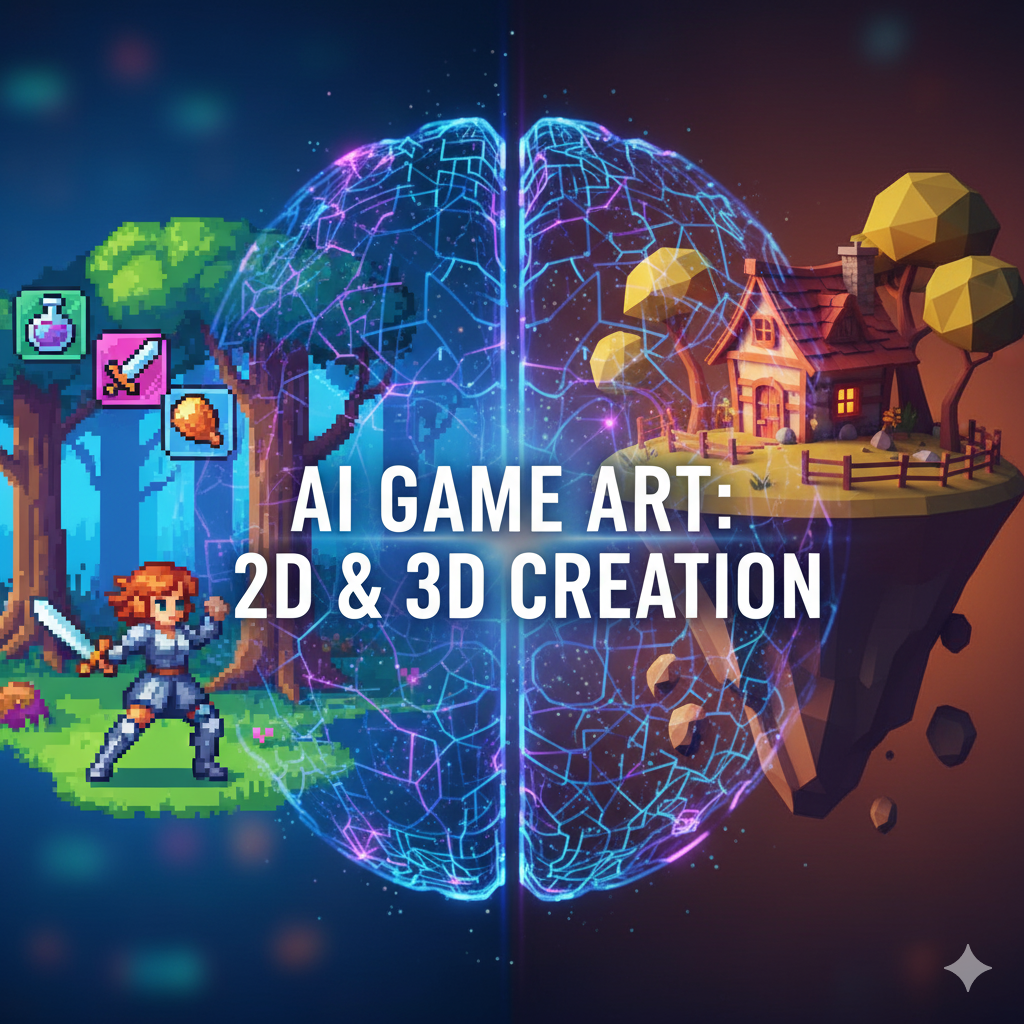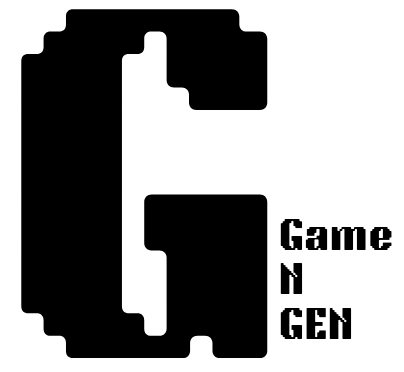Making a video game is exciting, but it has a lot of moving parts—especially when it comes to creating art. Drawing 2D characters and building 3D worlds can take months of hard work. That’s where new AI art tools can completely change the game.
These smart tools can speed up many art tasks, letting you spend less time on small details and more time on the big picture.

In this guide, we’ll explore why AI image generation matters, how it helps both small and large game-making teams, and which tools might be right for you. By the end, you’ll know how AI can help you make art for your game faster so you can focus on what’s most important: making your game fun.
1. Why AI Tools Are Changing Game Art
For years, making art for games took a lot of work. Artists had to draw every picture for an animation, paint every texture for a wall, and shape every 3D model by hand. This took a very long time. If you have a small team (or are working all by yourself), it can feel like too much to do.
This is why tools that save time are so valuable, as making a game can be quite costly (you can even check with our Game Development Cost Calculator).
AI tools for game asset creation are here to help fix that. They use smart computer programs to make concept art, create textures, suggest colors, or even help with 3D characters. This frees up your artists from doing the same boring tasks over and over, giving them more time to be creative.
Speed and Efficiency
One of the biggest wins is speed. An AI can create dozens of ideas for a background in the time it takes a person to draw one. It can also test out different color combinations for a character, letting you pick the best one without trying each one by hand. This speed is a huge help if you have a deadline to meet.
Boosting Creativity
It might sound strange, but AI can actually help you come up with new ideas. Sometimes, an AI-made image will show you a look you never would have thought of. You can then take that cool idea and make it even better. This can be a great way to brainstorm and get new inspiration.
2. Making 2D Game Art with AI
Even if your game has a classic pixel art look or hand-painted backgrounds, AI can still help. Let’s see how.
- Automatic Sprite Variations: Need different outfits or poses for your characters? AI tools can take one drawing and create many different versions. You can get new hairstyles, different colored clothes, or added accessories automatically.
- Upscaling Old Art: AI can make old, low-resolution pictures bigger and clearer without making them look blurry. This is perfect for updating an old game for new, bigger screens.
Once you have all those assets, you might need to make sure they’re not too big! Our Game Asset Image Compression tool can help with that.
- Color Palette Suggestions: Picking the right colors can be hard. AI can give you a set of colors that match a certain feeling, like a spooky forest or a happy town. This helps keep your game’s style looking good and consistent.
3. Using AI for 3D Models and Textures
Building a 3D game means even more work: modeling, texturing, and animation. Here’s how AI helps with the 2D/3D art pipeline.
- Creating Basic 3D Models: You can tell an AI what you want, like a “small wooden treasure chest,” and it can create a basic 3D model for you. It’s a great starting point that you can then polish in a program like Blender.
- Smart Texturing: A good texture makes a model look real. AI can look at pictures of things like “worn metal” or “mossy stone” and create a brand-new texture that fits your 3D object perfectly.
- Quick Rigging and Animation: “Rigging” is like putting a skeleton inside a 3D character so it can move. AI can help set up this skeleton automatically. It can even apply a simple walking or running animation, which is great for background characters who don’t need to be perfect.
4. Popular AI Platforms and Tools
There are many AI art tools out there. Here are a few popular ones that game developers use.
- Midjourney & DALL-E: These are tools where you type in words (a “prompt”) and the AI creates a picture for you. They are amazing for getting ideas for characters, worlds, and scenes.
- Artbreeder: This tool lets you mix and “breed” images together to create new ones. It’s great for making unique character faces or strange landscapes.
- Scenario: This tool is made just for game developers. You can teach it your game’s special art style, and it will create new pictures that match that style.
5. A Closer Look: Stable Diffusion for Games
One of the most powerful and popular tools is Stable Diffusion. What makes it so special for game developers?
Think of Stable Diffusion as your own personal robot artist that you can teach. Unlike other tools that you can only use on their website, you can download Stable Diffusion and run it on your own computer.
This is a huge deal for a few reasons:
- You Can Train It: You can “train” a Stable Diffusion model on your own game’s art. If your game has a unique cartoon or pixel art style, you can teach the AI that style. Then, every new picture it makes will fit perfectly into your game’s world.
- It’s More Controllable: There are tons of extra tools and settings for Stable Diffusion that give you more control over the final image.
- It’s Private: Because you run it yourself, your art and ideas stay private.
Using Stable Diffusion for games is becoming a go-to method for creating everything from item icons to character portraits and textures.
6. Tutorial: Creating Your First Asset with an AI Calculator
Ready to try it out? Let’s walk through how to create a simple game asset using an easy-to-use AI tool, like our Stable Diffusion Image Generation Calculator.
Let’s say we need an icon for a “Magic Health Potion” for our fantasy game.
Step 1: Write a Simple Prompt First, we need to tell the AI what we want. Be clear and descriptive. Go to the tool and in the “Prompt” box, type what you see in your mind.
- Prompt:
A glowing red health potion in a simple glass bottle, fantasy game icon, cartoon style, on a plain white background
Step 2: Add a Negative Prompt (What to Avoid) The “Negative Prompt” box is where you tell the AI what you don’t want to see. This helps clean up the picture.
- Negative Prompt:
blurry, text, words, signature, ugly, dark, shadows
Step 3: Choose Your Settings Our tool lets you pick a style. Since we put “cartoon style” in our prompt, let’s make sure the style setting is also set to “Cartoon” or “Digital Art” to help the AI.
Step 4: Generate and Refine! Now, click the “Generate” button! The AI will create a few different pictures based on your prompt.
Look at the results. Maybe one is perfect! Or maybe one is close, but the bottle is blue. You can go back and change your prompt to be even more specific, like bright red health potion, and click “Generate” again. Keep trying until you get an icon you love!
7. Tips for Getting the Best AI Art
- Be Super Specific: The more details you give, the better. Instead of “a sword,” try “a long, glowing elven sword with a golden hilt.”
- Iterate, Iterate, Iterate: Your first try might not be perfect. Think of it as a conversation. Change your prompts and try again to get closer to what you want.
- Use the Human Touch: The best way to use AI is as a helper. Let it create the basic idea, then have a human artist add the final touches to make it perfect and full of life.
8. Is AI Art a Good or Bad Thing?
Like any tool, AI has good and bad sides.
The Good Parts:
- Saves Time & Money: Helps small teams make great-looking art.
- Sparks New Ideas: Can help you think of creative designs you might have missed.
- Makes More Possible: You can create huge worlds with lots of unique items.
The Tricky Parts:
- Quality Can Be Random: Not every picture the AI makes will be good.
- It Can Look Generic: If you’re not careful, AI art can sometimes look a little plain or “soulless.”
- Legal & Ethical Questions: There are still questions about who owns AI art and if it’s fair to use other artists’ work to train an AI. Always use tools that are open about where their data comes from.
9. What’s Next for AI in Game Development?
AI’s role in making games is only going to get bigger. Soon, we might see AI tools that can build entire game levels from a simple description. We might also see smarter animation tools that make characters move more realistically.
The goal is not for AI to replace human artists, but to give them superpowers. By handling the slow, boring parts of art creation, AI gives developers more time to dream, create, and build the fun, memorable games we all love to play.
